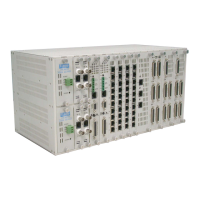CHAPTER 8 Appendix A: Quality of Service (QoS) Setup
53
8.2.1. QoS for Ingress Traffic – Writing Data From Ethernet Interface To Its Queues
In IP Networks, Quality of Service (QoS) serves as an essential role to guarantee the transmission
quality of service of the packets in a Best-Effort environment. Real-time video and voice data, for
example, require larger bandwidth and smaller transmission delay variation than e-mail service. It is
assumed that the network manager can recognize applications, such as voice, video, or email traffic,
and can evaluate their relative time-sensitivity or importance before the site installation. The network
manager can then group the applications into classes, which determine those frames with higher
priority for transmission and those which possess lower priority. QoS happens to be the technique that
groups data into different priorities. In other words, applying QoS is to maintain the quality of service
within IP Networks. Based on various techniques of QoS, setting procedures will become distinct. For
TDMoE card, three types of QoS concerning ingress traffic are available: Fixed, CoS, and ToS, which
define the way data are written from Ethernet interface to its own queues. The setup screen is shown
as below.
SLOT 2 TDMoE === Priority Mode Setup === 10:40:53 12/31/2009
ARROW KEYS: CURSOR MOVE, TAB: ROLL OPTIONS
ETH1: Fixed
ETH2: Fixed
ETH3: Fixed
ETH4: Fixed
<< Press ESC key to return to previous menu >>
(VT-100 Terminal Path: Main Menu > (S) System Setup > (C) QoS Setup > (A) Class of Service >
(A) Priority Mode Setup)
For further information of Fixed, CoS, and ToS priority modes, please refer to the relevant section
beneath.
8.2.1.1. Fixed Priority Setup
If the “Priority Mode” of interfaces is set as “Fixed” mode, the next step is to configure the “Fixed Priority
Setup”. The screen is shown as below.
SLOT 2 TDMoE === Fixed Priority Setup === 13:17:01 12/31/2009
ARROW KEYS: CURSOR MOVE, TAB: ROLL OPTIONS
Transmission priority
ETH1: P0
ETH2: P0
ETH3: P0
ETH4: P0
NOTE: Priority:P3 > P2 > P1 > P0
<< Press ESC key to return to previous menu >>
(VT-100 Terminal Path: Main Menu > (S) System Setup > (C) QoS Setup > (A) Class of Service > (B)
Fixed Priority Setup)
NOTE: Transmission priority = Queue, thus P0 = Queue0, P1 = Queue1 and so on.
Configuring the priority mode of an interface as Fixed implies the relationship between LAN side
interfaces and transmission priorities (its queues) are fixed. For example, if the priority mode for both
ETH1 and ETH2 is Fixed and their transmission priorities are set as P1 and P0, respectively, this
suggests frames entering ETH1 will be assigned to its own P1(Queue1), and ingress traffic of ETH2 will
be sent to its own P0(Queue0).

